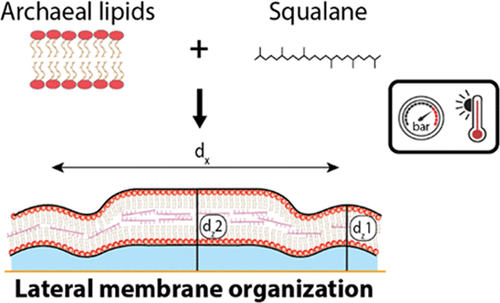Our official English website, www.x-mol.net, welcomes your feedback! (Note: you will need to create a separate account there.)
Lipid Phase Separation Induced by the Apolar Polyisoprenoid Squalane Demonstrates Its Role in Membrane Domain Formation in Archaeal Membranes.
Langmuir ( IF 3.9 ) Pub Date : 2020-06-09 , DOI: 10.1021/acs.langmuir.0c00901 Marta Salvador-Castell 1 , Bruno Demé 2 , Phil Oger 1 , Judith Peters 2, 3
Langmuir ( IF 3.9 ) Pub Date : 2020-06-09 , DOI: 10.1021/acs.langmuir.0c00901 Marta Salvador-Castell 1 , Bruno Demé 2 , Phil Oger 1 , Judith Peters 2, 3
Affiliation

|
Archaea synthesize methyl-branched, ether phospholipids, which confer the archaeal membrane exceptional physicochemical properties. A novel membrane organization was proposed recently to explain the thermal and high pressure tolerance of the polyextremophilic archaeon Thermococcus barophilus. According to this theoretical model, apolar molecules could populate the midplane of the bilayer and could alter the physicochemical properties of the membrane, among which is the possibility to form membrane domains. We tested this hypothesis using neutron diffraction on a model archaeal membrane composed of two archaeal diether lipids with phosphocholine and phosphoethanolamine headgroups in the presence of the apolar polyisoprenoid squalane. We show that squalane is inserted in the midplane at a maximal concentration between 5 and 10 mol % and that squalane can modify the lateral organization of the membrane and induces the coexistence of separate phases. The lateral reorganization is temperature- and squalane concentration-dependent and could be due to the release of lipid chain frustration and the induction of a negative curvature in the lipids.
中文翻译:

非极性聚异戊二烯角鲨烷诱导的脂质相分离表明其在古细菌膜的膜结构域形成中的作用。
古细菌合成甲基支化的醚磷脂,赋予古细菌膜卓越的理化特性。最近提出了一种新的膜组织来解释多极端嗜热古菌嗜热球菌的耐热性和高压耐受性。根据该理论模型,非极性分子可能位于双层的中平面,并可能改变膜的理化性质,其中有可能形成膜结构域。我们在非极性聚异戊二烯角鲨烷的存在下,在由两种古细菌二醚脂质与磷胆碱和磷酸乙醇胺头基组成的古细菌膜上使用中子衍射测试了这一假设。我们显示角鲨烷以5至10 mol%之间的最大浓度插入中平面,并且角鲨烷可以修饰膜的侧向组织并诱导分离相的共存。
更新日期:2020-07-07
中文翻译:

非极性聚异戊二烯角鲨烷诱导的脂质相分离表明其在古细菌膜的膜结构域形成中的作用。
古细菌合成甲基支化的醚磷脂,赋予古细菌膜卓越的理化特性。最近提出了一种新的膜组织来解释多极端嗜热古菌嗜热球菌的耐热性和高压耐受性。根据该理论模型,非极性分子可能位于双层的中平面,并可能改变膜的理化性质,其中有可能形成膜结构域。我们在非极性聚异戊二烯角鲨烷的存在下,在由两种古细菌二醚脂质与磷胆碱和磷酸乙醇胺头基组成的古细菌膜上使用中子衍射测试了这一假设。我们显示角鲨烷以5至10 mol%之间的最大浓度插入中平面,并且角鲨烷可以修饰膜的侧向组织并诱导分离相的共存。


























 京公网安备 11010802027423号
京公网安备 11010802027423号